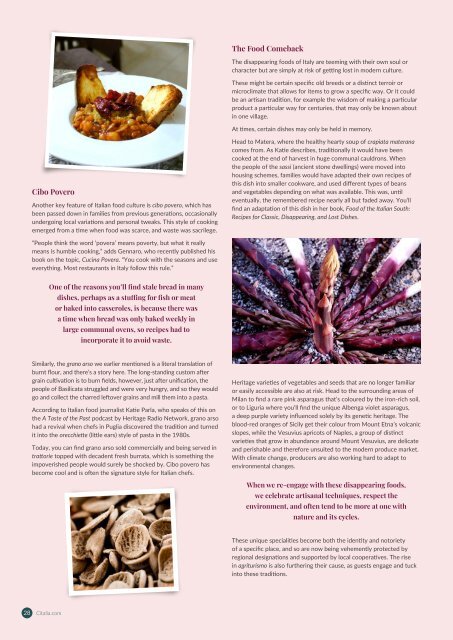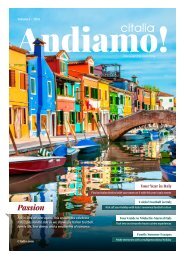Andiamo! Citalia Magazine Spring/Summer 2023
We are delighted to introduce you to issue eight of Andiamo!, the magazine from Citalia. This edition is focused on exploring and discovering the real Italy, leaving the bustling cities behind for the Treasures of the Coast. Follow in the footsteps of Indiana Jones as he takes us on an adventure in Sicily in the fifth instalment of the film franchise. Alternatively, enjoy the magic of the lakes with our feature on the lesser-known gems in the north. If you're seeking a different experience, step off the beaten path and discover the Top 5 Things to Do in Calabria – there's something for everyone! We are confident that you'll find lots of inspiration for your next adventure in this issue of Andiamo!, regardless of whenever you're planning to visit Italy next.
We are delighted to introduce you to issue eight of Andiamo!, the magazine from Citalia. This edition is focused on exploring and discovering the real Italy, leaving the bustling cities behind for the Treasures of the Coast.
Follow in the footsteps of Indiana Jones as he takes us on an adventure in Sicily in the fifth instalment of the film franchise. Alternatively, enjoy the magic of the lakes with our feature on the lesser-known gems in the north.
If you're seeking a different experience, step off the beaten path and discover the Top 5 Things to Do in Calabria – there's something for everyone! We are confident that you'll find lots of inspiration for your next adventure in this issue of Andiamo!, regardless of whenever you're planning to visit Italy next.
You also want an ePaper? Increase the reach of your titles
YUMPU automatically turns print PDFs into web optimized ePapers that Google loves.
The Food Comeback<br />
The disappearing foods of Italy are teeming with their own soul or<br />
character but are simply at risk of getting lost in modern culture.<br />
These might be certain specific old breeds or a distinct terroir or<br />
microclimate that allows for items to grow a specific way. Or it could<br />
be an artisan tradition, for example the wisdom of making a particular<br />
product a particular way for centuries, that may only be known about<br />
in one village.<br />
At times, certain dishes may only be held in memory.<br />
Cibo Povero<br />
Another key feature of Italian food culture is cibo povero, which has<br />
been passed down in families from previous generations, occasionally<br />
undergoing local variations and personal tweaks. This style of cooking<br />
emerged from a time when food was scarce, and waste was sacrilege.<br />
Head to Matera, where the healthy hearty soup of crapiata materana<br />
comes from. As Katie describes, traditionally it would have been<br />
cooked at the end of harvest in huge communal cauldrons. When<br />
the people of the sassi (ancient stone dwellings) were moved into<br />
housing schemes, families would have adapted their own recipes of<br />
this dish into smaller cookware, and used different types of beans<br />
and vegetables depending on what was available. This was, until<br />
eventually, the remembered recipe nearly all but faded away. You’ll<br />
find an adaptation of this dish in her book, Food of the Italian South:<br />
Recipes for Classic, Disappearing, and Lost Dishes.<br />
“People think the word ‘povera’ means poverty, but what it really<br />
means is humble cooking,” adds Gennaro, who recently published his<br />
book on the topic, Cucina Povera. “You cook with the seasons and use<br />
everything. Most restaurants in Italy follow this rule.”<br />
One of the reasons you’ll find stale bread in many<br />
dishes, perhaps as a stuffing for fish or meat<br />
or baked into casseroles, is because there was<br />
a time when bread was only baked weekly in<br />
large communal ovens, so recipes had to<br />
incorporate it to avoid waste.<br />
Similarly, the grano arso we earlier mentioned is a literal translation of<br />
burnt flour, and there’s a story here. The long-standing custom after<br />
grain cultivation is to burn fields, however, just after unification, the<br />
people of Basilicata struggled and were very hungry, and so they would<br />
go and collect the charred leftover grains and mill them into a pasta.<br />
According to Italian food journalist Katie Parla, who speaks of this on<br />
the A Taste of the Past podcast by Heritage Radio Network, grano arso<br />
had a revival when chefs in Puglia discovered the tradition and turned<br />
it into the orecchiette (little ears) style of pasta in the 1980s.<br />
Today, you can find grano arso sold commercially and being served in<br />
trattorie topped with decadent fresh burrata, which is something the<br />
impoverished people would surely be shocked by. Cibo povero has<br />
become cool and is often the signature style for Italian chefs.<br />
Heritage varieties of vegetables and seeds that are no longer familiar<br />
or easily accessible are also at risk. Head to the surrounding areas of<br />
Milan to find a rare pink asparagus that’s coloured by the iron-rich soil,<br />
or to Liguria where you’ll find the unique Albenga violet asparagus,<br />
a deep purple variety influenced solely by its genetic heritage. The<br />
blood-red oranges of Sicily get their colour from Mount Etna’s volcanic<br />
slopes, while the Vesuvius apricots of Naples, a group of distinct<br />
varieties that grow in abundance around Mount Vesuvius, are delicate<br />
and perishable and therefore unsuited to the modern produce market.<br />
With climate change, producers are also working hard to adapt to<br />
environmental changes.<br />
When we re-engage with these disappearing foods,<br />
we celebrate artisanal techniques, respect the<br />
environment, and often tend to be more at one with<br />
nature and its cycles.<br />
These unique specialities become both the identity and notoriety<br />
of a specific place, and so are now being vehemently protected by<br />
regional designations and supported by local cooperatives. The rise<br />
in agriturismo is also furthering their cause, as guests engage and tuck<br />
into these traditions.<br />
28<br />
<strong>Citalia</strong>.com
















